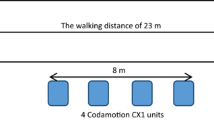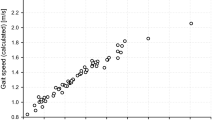Abstract
Populations around the world are rapidly ageing as the population aged 65 and over is growing faster than all other age groups. Most of the daily life actions of active elderly are related to walking activities, thus guaranteeing walking environments that are elderly-friendly are nowadays a priority to ensure healthy aging. Measuring and recognizing the affective state of people during walking activities contribute to a better comprehension of their perception of the environment, and a better definition of walkable urban area. With the aim of paving the way for assessing walkability, introducing quantitative evaluation tools, this work proposes to compare physiological responses of subjects of different ages, in different walking conditions. To this end a proper experiment has been designed in a controlled environment, considering both young adults and elderly, and adopting wearable devices. In this paper the analysis of the leg muscles activity acquired with Electromyography is presented. The results of this preliminary study highlight age-related differences in subjects facing both forced speed walks and collision avoidance tasks.
Access this chapter
Tax calculation will be finalised at checkout
Purchases are for personal use only
Similar content being viewed by others
Notes
References
Bandini, S., Gasparini, F.: Towards affective walkability for healthy ageing in the future of the cities. In: Proceedings of the 5th Workshop on Artificial Intelligence for Ambient Assisted Living, AIxIA 2019, vol. 2559. CEUR-WS (2020)
U.S. Census Bureau: 2017 National Population Projections Datasets (2017)
Can, Y.S., Arnrich, B., Ersoy, C.: Stress detection in daily life scenarios using smart phones and wearable sensors: a survey. J. Biomed. Inform. 92, 103139 (2019)
Donoho, D.L., Johnstone, J.M.: Ideal spatial adaptation by wavelet shrinkage. Biometrika 81(3), 425–455 (1994)
Gaglione, F., Cottrill, C., Gargiulo, C.: Urban services, pedestrian networks and behaviors to measure elderly accessibility. Transp. Res. Part D: Transp. Environ. 90, 102687 (2021)
Halaki, M., Ginn, K.: Normalization of EMG signals: to normalize or not to normalize and what to normalize to. In: Computational Intelligence in Electromyography Analysis-A Perspective on Current Applications and Future Challenges, pp. 175–194 (2012)
Hoeger, W.W., Bond, L., Ransdell, L., Shimon, J.M., Merugu, S.: One-mile step count at walking and running speeds. ACSM’s Health Fitness J. 12(1), 14–19 (2008)
Hu, B., Dixon, P., Jacobs, J., Dennerlein, J., Schiffman, J.: Machine learning algorithms based on signals from a single wearable inertial sensor can detect surface-and age-related differences in walking. J. Biomech. 71, 37–42 (2018)
Ji, T., Pachi, A.: Frequency and velocity of people walking. Struct. Eng. 84(3), 36–40 (2005)
Kim, H.: Wearable sensor data-driven walkability assessment for elderly people. Sustainability 12(10), 4041 (2020)
King, A.C., et al.: Employing participatory citizen science methods to promote age-friendly environments worldwide. Int. J. Environ. Res. Public Health 17(5), 1541 (2020)
Le, T.P.L., Leung, A., Kavalchuk, I., Nguyen, H.N.: Age-proofing a traffic saturated metropolis-evaluating the influences on walking behaviour in older adults in Ho Chi Minh City. Travel Behav. Soc. 23, 1–12 (2021)
Lee, G., Choi, B., Jebelli, H., Ahn, C.R., Lee, S.: Wearable biosensor and collective sensing-based approach for detecting older adults’ environmental barriers. J. Comput. Civ. Eng. 34(2), 04020002 (2020)
Moon, S., et al.: Classification of Parkinson’s disease and essential tremor based on balance and gait characteristics from wearable motion sensors via machine learning techniques: a data-driven approach. J. NeuroEng. Rehabil. 17(1), 1–8 (2020)
Phinyomark, A., Limsakul, C., Phukpattaranont, P.: A novel feature extraction for robust EMG pattern recognition. arXiv preprint arXiv:0912.3973 (2009)
Wei, G., Tian, F., Tang, G., Wang, C.: A wavelet-based method to predict muscle forces from surface electromyography signals in weightlifting. J. Bionic Eng. 9(1), 48–58 (2012)
Wren, M.A., et al.: Projections of demand for healthcare in Ireland, 2015–2030: first report from the Hippocrates model. ESRI Research Series Number 67 October 2017 (2017)
Yetisen, A.K., Martinez-Hurtado, J.L., Ünal, B., Khademhosseini, A., Butt, H.: Wearables in medicine. Adv. Mater. 30(33), 1706910 (2018)
Zhang, X., Tang, X., Zhu, X., Gao, X., Chen, X., Chen, X.: A regression-based framework for quantitative assessment of muscle spasticity using combined EMG and inertial data from wearable sensors. Front. Neurosci. 13, 398 (2019)
Acknowledgment
This research is partially supported by Fondazione Cariplo, for the project LONGEVICITY - Social Inclusion for the Elderly through Walkability (Ref. 2017-0938) and by the Japan Society for the Promotion of Science (Ref. L19513). We want to give our thanks to Kenichiro Shimura and Daichi Yanagisawa, for their supporting work during the experimentation.
Author information
Authors and Affiliations
Corresponding author
Editor information
Editors and Affiliations
Rights and permissions
Copyright information
© 2021 Springer Nature Switzerland AG
About this paper
Cite this paper
Gasparini, F., Grossi, A., Nishinari, K., Bandini, S. (2021). Age-Related Walkability Assessment: A Preliminary Study Based on the EMG. In: Baldoni, M., Bandini, S. (eds) AIxIA 2020 – Advances in Artificial Intelligence. AIxIA 2020. Lecture Notes in Computer Science(), vol 12414. Springer, Cham. https://doi.org/10.1007/978-3-030-77091-4_25
Download citation
DOI: https://doi.org/10.1007/978-3-030-77091-4_25
Published:
Publisher Name: Springer, Cham
Print ISBN: 978-3-030-77090-7
Online ISBN: 978-3-030-77091-4
eBook Packages: Computer ScienceComputer Science (R0)




